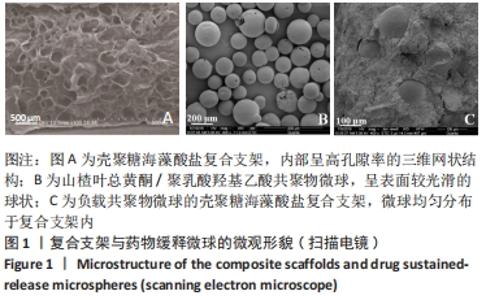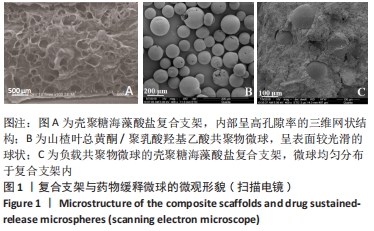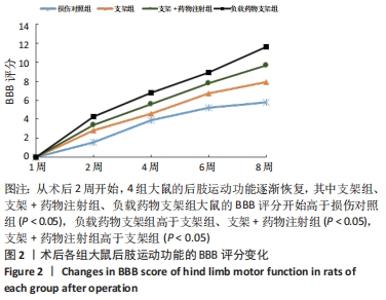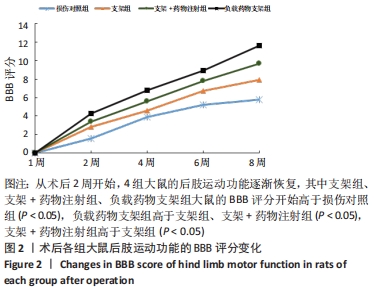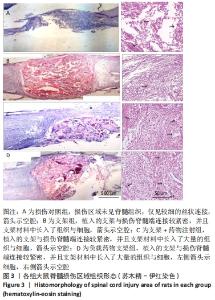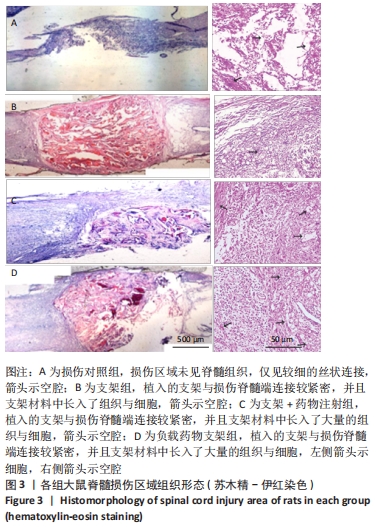Chinese Journal of Tissue Engineering Research ›› 2022, Vol. 26 ›› Issue (28): 4466-4471.doi: 10.12307/2022.299
Previous Articles Next Articles
Chitosan/alginate composite scaffold combined with hawthorn leaf flavonoids for spinal cord injury repair
Liu Ming, Wang Kai
- First Department of Orthopedics, Qinghai Provincial People’s Hospital, Xining 810000, Qinghai Province, China
-
Received:2020-12-21Accepted:2021-01-23Online:2022-10-08Published:2022-03-21 -
Contact:Wang Kai, Chief physician, First Department of Orthopedics, Qinghai Provincial People’s Hospital, Xining 810000, Qinghai Province, China -
About author:Liu Ming, Master, Associate chief physician, First Department of Orthopedics, Qinghai Provincial People’s Hospital, Xining 810000, Qinghai Province, China
CLC Number:
Cite this article
Liu Ming, Wang Kai. Chitosan/alginate composite scaffold combined with hawthorn leaf flavonoids for spinal cord injury repair[J]. Chinese Journal of Tissue Engineering Research, 2022, 26(28): 4466-4471.
share this article
Add to citation manager EndNote|Reference Manager|ProCite|BibTeX|RefWorks
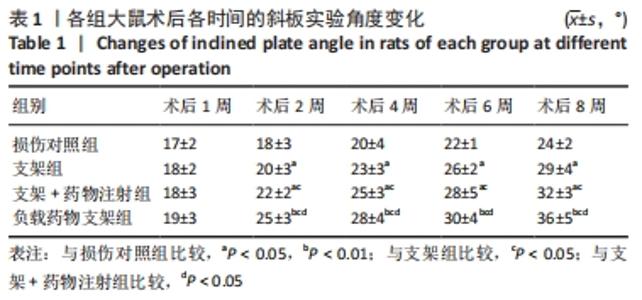
2.3 各组大鼠斜板实验结果 随着术后时间的延长,各组大鼠斜板实验角度逐渐增大,损伤对照组术后4,6,8周的斜板实验角度均大于术后1周(P < 0.05),并且术后4,6,8周的斜板实验角度比较差异有显著性意义(P < 0.05);其余3组组内术后1,2,4,6,8周的斜板实验角度比较差异均有显著性意义(P < 0.05)。 术后1周时,4组斜板实验角度比较差异无显著性意义(P ﹥0.05);术后2周时,4组斜板实验角度存在差异,支架组、支架+药物注射组、负载药物支架组斜板实验角度大于损伤对照组(P < 0.05),负载药物支架组大于支架组、支架+药物注射组(P < 0.05),支架+药物注射组大于支架组(P < 0.05),并且该差异一直持续至术后8周。各组大鼠术后各时间的斜板实验角度变化,见表1。"
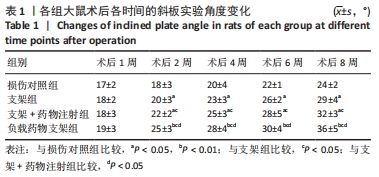
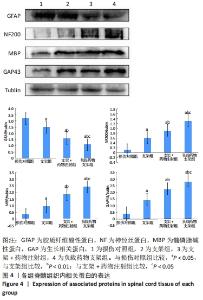
2.5 各组大鼠脊髓Western Blot检测 术后8周时利用Western Blot 检测4组脊髓组织中胶质纤维酸性蛋白、神经丝蛋白200、髓磷脂碱性蛋白、生长相关蛋白43的蛋白相对表达,结果显示:损伤对照组可见较强的胶质纤维酸性蛋白蛋白条带,较微弱的神经丝蛋白200、髓磷脂碱性蛋白、生长相关蛋白43蛋白条带;其余3组的胶质纤维酸性蛋白蛋白弱于损伤对照组,神经丝蛋白200、髓磷脂碱性蛋白、生长相关蛋白43的蛋白条带强于损伤对照组。 半定量分析结果显示,支架组、支架+药物注射组、负载药物支架组胶质纤维酸性蛋白的蛋白表达低于损伤对照组(P < 0.05),负载药物支架组低于支架组、支架+药物注射组(P < 0.05),支架+药物注射组低于支架组(P < 0.05);支架组、支架+药物注射组、负载药物支架组神经丝蛋白200、髓磷脂碱性蛋白、生长相关蛋白43蛋白表达高于损伤对照组(P < 0.05),负载药物支架组神经丝蛋白200、髓磷脂碱性蛋白、生长相关蛋白43的蛋白表达高于支架组、支架+药物注射组(P < 0.05),支架+药物注射组神经丝蛋白200、髓磷脂碱性蛋白、生长相关蛋白43的蛋白表达高于支架组(P < 0.05)。各组脊髓组织胶质纤维酸性蛋白、神经丝蛋白200、髓磷脂碱性蛋白、生长相关蛋白43的蛋白检测结果见图4。"
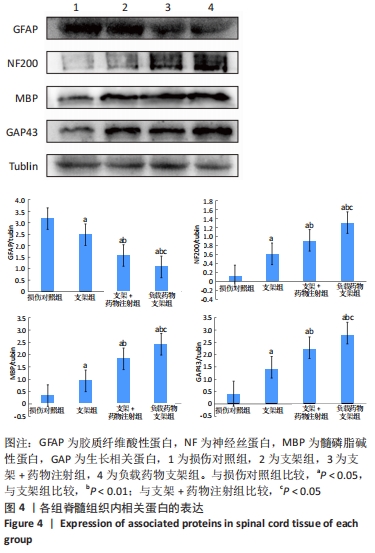
| [1] MOURELO FARIÑA M, SALVADOR DE LA BARRERA S, MONTOTO MARQUÉS A, et al. Update on traumatic acute spinal cord injury. Part 2. Med Intensiva. 2017;41(5):306-315. [2] 桂彤,杨超,何炳书,等. 急性脊髓损伤早期应用大剂量甲基泼尼松龙辅助治疗效果观察[J].山东医药,2016,56(42):65-66. [3] 贺宝荣,郑博隆.中国脊髓损伤规范化治疗和修复机制研究概况[J].中华创伤杂志,2020,36(4):289-292. [4] PAPA S, ROSSI F, VISMARA I, et al. Nanovector-Mediated Drug Delivery in Spinal Cord Injury: A Multitarget Approach. ACS Chem Neurosci. 2019; 10(3):1173-1182. [5] THYGESEN MM, GULDBÆK-SVENSSON F, RASMUSSEN MM, et al. Contusion Spinal Cord Injury via a Microsurgical Laminectomy in the Regenerative Axolotl. J Vis Exp. 2019;(152). doi: 10.3791/60337. [6] 李建.选择性损伤节段植骨融合结合椎弓根置钉治疗胸腰椎爆裂骨折并脊髓损伤疗效分析[J].浙江医学,2020,42(8):837-840. [7] 王寒明,王欢,郄淑燕,等.早期综合康复疗法对脊髓损伤患者的康复效果[J].中国临床研究,2019,32(1):89-92. [8] 孔维健,方红娟,潘肃,等.搭载紫杉醇脂质体的聚乳酸-羟基乙酸共聚物静电纺丝膜对神经干细胞增殖分化的影响[J].吉林大学学报(医学版),2020,46(3):509-514. [9] 周继辉,姚猛,王岩松,等.纳米组织工程化脊髓修复脊髓损伤[J].中国组织工程研究,2021,25(10):1550-1554. [10] REZAEI-GOLMISHEH A, MALEKINEJAD H, ASRI-REZAEI S, et al. Hawthorn ethanolic extracts with triterpenoids and flavonoids exert hepatoprotective effects and suppress the hypercholesterolemia-induced oxidative stress in rats. Iran J Basic Med Sci. 2015;18(7):691-699. [11] WANG DJ, CAI YQ, PAN SZ, et al. Effect of Total Flavone of Haw Leaves on Nuclear Factor Erythroid-2 Related Factor and Other Related Factors in Nonalcoholic Steatohepatitis Rats. Chin J Integr Med. 2018;24(4):265-271. [12] 李丽静,王领弟,吴晓光.山楂叶总黄酮通过调控miR-133b改善缺氧复氧诱导的神经细胞损伤[J].中成药,2020,42(6):1443-1449 [13] 苗光新,李蒙蒙,吴晓光.山楂叶总黄酮对脑缺血大鼠Caspase-3蛋白及炎症因子表达的影响[J].中国老年学杂志,2019,39(10):2487-2490. [14] RENNO WM, BENOV L, KHAN KM. Possible role of antioxidative capacity of (-)-epigallocatechin-3-gallate treatment in morphological and neurobehavioral recovery after sciatic nerve crush injury. J Neurosurg Spine. 2017;27(5):593-613. [15] ZHANG Q, XIONG Y, LI B, et al. Total flavonoids of hawthorn leaves promote motor function recovery via inhibition of apoptosis after spinal cord injury. Neural Regen Res. 2021;16(2):350-356. [16] 郑华斌,罗琳,陈路.壳聚糖藻酸盐支架与脂肪间充质干细胞复合构建的组织工程脊髓修复急性脊髓损伤[J].中国组织工程研究,2017, 21(26):4199-4204. [17] 鲍玉成,张文龙,王勇,等.聚乳酸羟基乙酸-环丝氨酸缓释微球植入剂的制备及其体外释药性能[J].中国组织工程研究,2018,22(6):871-876. [18] KUMAR R, LIM J, MEKARY RA, et al. Traumatic Spinal Injury: Global Epidemiology and Worldwide Volume. World Neurosurg. 2018;113:e345-e363. [19] LANGER R, VACANTI JP. Tissue engineering. Science. 1993;260(5110):920-926. [20] GUAN J, LIU Q, ZHANG X, et al. Alginate as a potential diphase solid dispersion carrier with enhanced drug dissolution and improved storage stability. Eur J Pharm Sci. 2018;114:346-355. [21] MD RAMLI SH, WONG TW, NAHARUDIN I, et al. Coatless alginate pellets as sustained-release drug carrier for inflammatory bowel disease treatment. Carbohydr Polym. 2016;152:370-381. [22] YUN Y, WU H, GAO J, et al. Facile synthesis of Ca(2+)-crosslinked sodium alginate/graphene oxide hybrids as electro- and pH-responsive drug carrier. Mater Sci Eng C Mater Biol Appl. 2020;108:110380. [23] XIE YL, JIANG W, LI F, et al. Controlled Release of Spirotetramat Using Starch-Chitosan-Alginate-Encapsulation. Bull Environ Contam Toxicol. 2020; 104(1):149-155. [24] 张强,刘士博,杨军星,等.载VEGF/VAN多层海藻酸盐-壳聚糖缓释微球的制备[J].吉林大学学报(医学版),2017,43(4):839-844. [25] 刁婷婷,张雨晨,吕伟,等.山楂叶总黄酮对胶质瘤U87细胞的抑制作用[J].中国药理学通报,2019,35(10):1448-1452. [26] 吴晓光,白江涛,苗光新,等.山楂叶总黄酮对慢性脑缺血大鼠p38MAPK信号通路的影响[J].中国老年学杂志,2018,38(5):1194-1196. [27] 付雯雯.山楂叶总黄酮通过下调TLR4/NF--κB信号通路减轻脊髓损伤大鼠急性炎症反应[D].南宁:广西医科大学,2019. [28] YAO ZA, CHEN FJ, CUI HL, et al. Efficacy of chitosan and sodium alginate scaffolds for repair of spinal cord injury in rats. Neural Regen Res. 2018; 13(3):502-509. [29] GAETANI L, BLENNOW K, CALABRESI P, et al. Neurofilament light chain as a biomarker in neurological disorders. J Neurol Neurosurg Psychiatry. 2019;90(8):870-881. [30] LEE Y, LEE BH, YIP W, et al. Neurofilament Proteins as Prognostic Biomarkers in Neurological Disorders. Curr Pharm Des. 2020;25(43):4560-4569. [31] 章殷希,郑扬,沈春红,等.自身免疫性胶质纤维酸性蛋白星形胶质细胞病[J].中华神经科杂志,2020,53(4):317-320. [32] 欧阳波,杨筱倩,丁煌,等.冰片配伍黄芪甲苷和三七总皂苷对脑缺 血/再灌注损伤后神经血管单元的保护作用[J].中国药理学通报,2020, 36(10):1470-1476. [33] 亢筝,邹造峰,孙婧娴,等.电针促进溶血卵磷脂诱导的脱髓鞘小鼠髓鞘再生修复作用机制研究[J].针刺研究,2020,45(1):1-7. [34] 孟仁亮,谢阳,张瑶,等.氯马斯汀促进实验性自身免疫性脑脊髓炎小鼠的再髓鞘化[J].天津医药,2019,47(8):819-823. [35] HUNG CC, LIN CH, CHANG H, et al. Astrocytic GAP43 Induced by the TLR4/NF-kappaB/STAT3 Axis Attenuates Astrogliosis-Mediated Microglial Activation and Neurotoxicity. J Neurosci. 2016;36(6):2027-2043. [36] ZAVVARI F, NAHAVANDI A, GOUDARZI M. Fluoxetine attenuates stress-induced depressive-like behavior through modulation of hippocampal GAP43 and neurogenesis in male rats. J Chem Neuroanat. 2020;103:101711. [37] GORUP D, BOHAČEK I, MILIČEVIĆ T, et al. Increased expression and colocalization of GAP43 and CASP3 after brain ischemic lesion in mouse. Neurosci Lett. 2015;597:176-182. |
| [1] | Kan Houming, Fan Lijun, Chen Xuetai, Shen Wen. Application of platelet-rich plasma in neuropathic pain [J]. Chinese Journal of Tissue Engineering Research, 2022, 26(8): 1286-1292. |
| [2] | Fan Yiming, Liu Fangyu, Zhang Hongyu, Li Shuai, Wang Yansong. Serial questions about endogenous neural stem cell response in the ependymal zone after spinal cord injury [J]. Chinese Journal of Tissue Engineering Research, 2022, 26(7): 1137-1142. |
| [3] | Hu Wei, Xie Xingqi, Tu Guanjun. Exosomes derived from bone marrow mesenchymal stem cells improve the integrity of the blood-spinal cord barrier after spinal cord injury [J]. Chinese Journal of Tissue Engineering Research, 2022, 26(7): 992-998. |
| [4] | Tan Guozhong, Tu Xinran, Guo Liyang, Zhong Jialin, Zhang Yang, Jiang Qianzhou. Biosafety evaluation of three-dimensional printed gelatin/sodium alginate/58S bioactive glass scaffolds for bone defect repair [J]. Chinese Journal of Tissue Engineering Research, 2022, 26(4): 521-527. |
| [5] | Jiang Haoran, Gao Jianming, Lin Wancheng, Li Ting, Li Huo, Wang Peng, Feng Jing, Meng Haoye, Peng Jiang, Ding Lixiang. Gelatin-alginate composite microspheres and gels for cartilage damage repair [J]. Chinese Journal of Tissue Engineering Research, 2022, 26(28): 4452-4457. |
| [6] | Liu Kang, Wang Yongping, Zuo Kebin, Yang Haitao, Jia Bin. Polydatin loaded collagen/heparin sulfate scaffold in the treatment of spinal cord injury in rats [J]. Chinese Journal of Tissue Engineering Research, 2022, 26(28): 4500-4506. |
| [7] | Fan Yi, Liu Yadong, Cui Yutao, Liu He, Tian Yuhang, Li Shaorong, Wang Gan, Wu Dankai, Peng Chuangang. Modification of natural and composite alginate hydrogels and repair of bone defect with composite systems [J]. Chinese Journal of Tissue Engineering Research, 2022, 26(28): 4532-4538. |
| [8] | Zhao Xingchang, Song Shiqiang, He Feng, Tang Yujin, Liu Jia. Application of biomaterial scaffolds in the treatment of spinal cord injury [J]. Chinese Journal of Tissue Engineering Research, 2022, 26(28): 4562-4568. |
| [9] | Liu Yin, Liu Qin, Chen Jiao, Gu Xianyang, Chen Jiawen, Ma Minxian. Properties of injectable gluconolactone-sodium alginate/beta-tricalcium phosphate/polyethylene glycol composite hydrogel scaffold [J]. Chinese Journal of Tissue Engineering Research, 2022, 26(27): 4308-4313. |
| [10] | Tang Fuyu, Zhou Binbin, Wei Weibing, Zhang Hongsheng. Effect of electroacupuncture on glial fibrillary acidic protein expression at the injured site in a rat model of spinal cord injury [J]. Chinese Journal of Tissue Engineering Research, 2022, 26(26): 4113-4117. |
| [11] | Shi Yao, Han Shufeng, Yuan Yitong, Du Ruochen, Jing Zhijie, Zhao Bichun, Zhang Ruxin, Zhang Yujuan, Wang Chunfang. Efficacy and safety of human umbilical cord mesenchymal stem cells in the treatment of spinal cord injury: a meta-analysis [J]. Chinese Journal of Tissue Engineering Research, 2022, 26(25): 4093-4100. |
| [12] | Li Jinglu, Wang Sainan, Wang Yangyang, Fu Guiqiang, Wang Ying, Hu Jianguo, Tang Jie, Lyu Hezuo. CRID3, a blocker of apoptosis-associated speck-like protein containing a card, influences local gene transcription in mice with acute spinal cord injury: a transcriptomic analysis [J]. Chinese Journal of Tissue Engineering Research, 2022, 26(23): 3620-3632. |
| [13] | Chen Pingbo, Wang Jing, Sun Yong, Xu Xiaofeng, Chen Qian, Zhang Zhijian. Genipin crosslinked sonic hedgehog composite fibrin scaffolds for the repair of spinal cord injury in rats [J]. Chinese Journal of Tissue Engineering Research, 2022, 26(21): 3345-3350. |
| [14] | Li Jianfeng, Zhang Shulian, Yan Jinyu, Li jiayi, Jin Zhao, Deng Qi. Vimentin silenced by small interfering RNA inhibits glial scar formation in a rat model of acute spinal cord injury [J]. Chinese Journal of Tissue Engineering Research, 2022, 26(20): 3190-3195. |
| [15] | Liu Yingsong, Guo Xiaopeng, Wei Mingzhu. Transforming growth factor beta 3 and alginate hydrogel complex on the repair of articular cartilage defects of the knee [J]. Chinese Journal of Tissue Engineering Research, 2022, 26(16): 2504-2509. |
| Viewed | ||||||
|
Full text |
|
|||||
|
Abstract |
|
|||||
